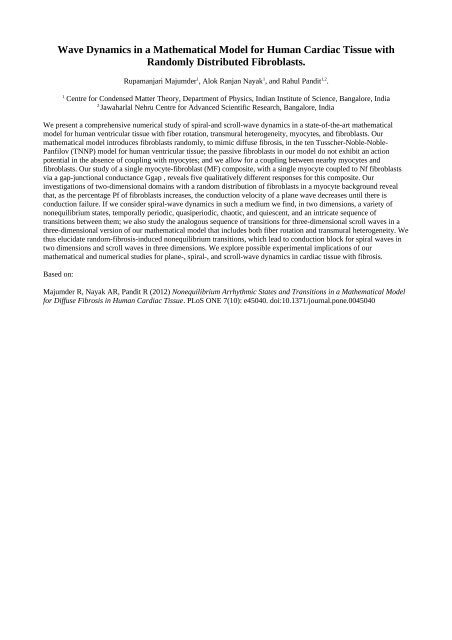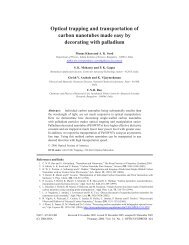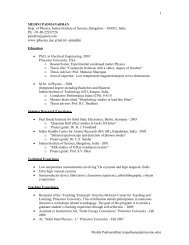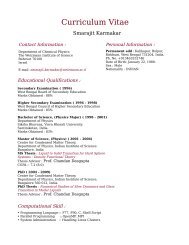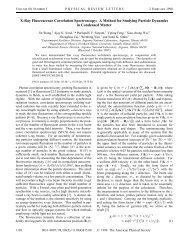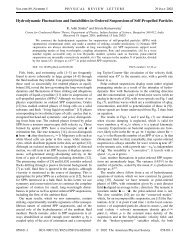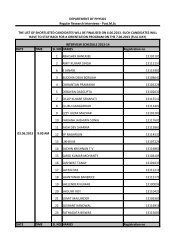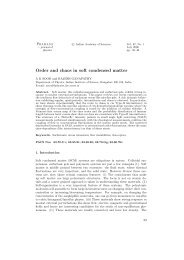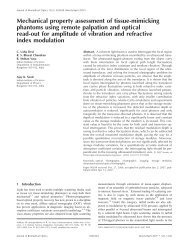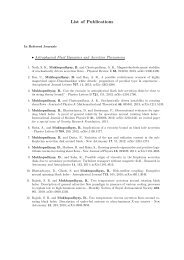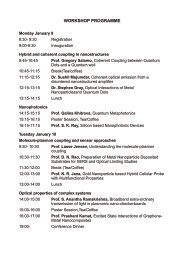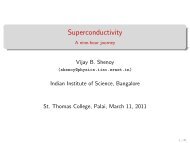Thermoelectric Properties of Fe0.2Co3.8Sb12-xTex ... - Physics
Thermoelectric Properties of Fe0.2Co3.8Sb12-xTex ... - Physics
Thermoelectric Properties of Fe0.2Co3.8Sb12-xTex ... - Physics
Create successful ePaper yourself
Turn your PDF publications into a flip-book with our unique Google optimized e-Paper software.
Wave Dynamics in a Mathematical Model for Human Cardiac Tissue with<br />
Randomly Distributed Fibroblasts.<br />
Rupamanjari Majumder 1 , Alok Ranjan Nayak 1 , and Rahul Pandit 1,2 .<br />
1<br />
Centre for Condensed Matter Theory, Department <strong>of</strong> <strong>Physics</strong>, Indian Institute <strong>of</strong> Science, Bangalore, India<br />
2<br />
Jawaharlal Nehru Centre for Advanced Scientific Research, Bangalore, India<br />
We present a comprehensive numerical study <strong>of</strong> spiral-and scroll-wave dynamics in a state-<strong>of</strong>-the-art mathematical<br />
model for human ventricular tissue with fiber rotation, transmural heterogeneity, myocytes, and fibroblasts. Our<br />
mathematical model introduces fibroblasts randomly, to mimic diffuse fibrosis, in the ten Tusscher-Noble-Noble-<br />
Panfilov (TNNP) model for human ventricular tissue; the passive fibroblasts in our model do not exhibit an action<br />
potential in the absence <strong>of</strong> coupling with myocytes; and we allow for a coupling between nearby myocytes and<br />
fibroblasts. Our study <strong>of</strong> a single myocyte-fibroblast (MF) composite, with a single myocyte coupled to Nf fibroblasts<br />
via a gap-junctional conductance Ggap , reveals five qualitatively different responses for this composite. Our<br />
investigations <strong>of</strong> two-dimensional domains with a random distribution <strong>of</strong> fibroblasts in a myocyte background reveal<br />
that, as the percentage Pf <strong>of</strong> fibroblasts increases, the conduction velocity <strong>of</strong> a plane wave decreases until there is<br />
conduction failure. If we consider spiral-wave dynamics in such a medium we find, in two dimensions, a variety <strong>of</strong><br />
nonequilibrium states, temporally periodic, quasiperiodic, chaotic, and quiescent, and an intricate sequence <strong>of</strong><br />
transitions between them; we also study the analogous sequence <strong>of</strong> transitions for three-dimensional scroll waves in a<br />
three-dimensional version <strong>of</strong> our mathematical model that includes both fiber rotation and transmural heterogeneity. We<br />
thus elucidate random-fibrosis-induced nonequilibrium transitions, which lead to conduction block for spiral waves in<br />
two dimensions and scroll waves in three dimensions. We explore possible experimental implications <strong>of</strong> our<br />
mathematical and numerical studies for plane-, spiral-, and scroll-wave dynamics in cardiac tissue with fibrosis.<br />
Based on:<br />
Majumder R, Nayak AR, Pandit R (2012) Nonequilibrium Arrhythmic States and Transitions in a Mathematical Model<br />
for Diffuse Fibrosis in Human Cardiac Tissue. PLoS ONE 7(10): e45040. doi:10.1371/journal.pone.0045040


